
This page provides links to graphics and diagrams related to the FUSE science programs.

Probing the Milky Way with FUSE
You are here! The sun's position in the Milky Way.
The sun is located in an outer region of the Milky Way galaxy, a huge pinwheel of
some 200 billion stars. In the "empty" regions between the stars lies a tenuous
component of gas and interstellar dust known to astronomers as the INTERSTELLAR MEDIUM.
(Click picture to see a larger version.)
The region studied previously.
In the 1970s, NASA flew a satellite known as Copernicus. This satellite looked
at the same range of light as FUSE, but with much lower sensitivity. Hence, it could
only be used to observe relatively bright stars in the region right around the sun
(green region in diagram). Copernicus demonstrated the need for a much more
powerful telescope to observe far-ultraviolet light, and that telescope is FUSE!
(Click picture to see a larger version.)
FUSE views the Milky Way.
Unlike Copernicus, FUSE will be able to see stars and nebulae in nearby spiral
arms and throughout our galaxy. FUSE is 10,000 times more sensitive than Copernicus,
and will be able to study HUNDREDS of sight-lines through the interstellar medium,
building up a detailed picture of the temperature structure and composition
of the gas and dust in our galaxy.
(Click picture to see a larger version.)
Beyond the Milky Way.
FUSE will also be able to observe the hottest stars in nearby galaxies (for comparison
with the Milky Way's stars), and will even be able to observe active galaxies and
quasars out to several billion light years away!
(Click picture to see a larger version.)
There is an on-line animation of this sequence available!


Searching Cosmic Barcodes
This link provides you with a clue as to how astronomers get information out of light by making an analogy with those familiar "barcodes" so prevalent in stores and supermarkets!


This graphic, produced by Ken Sembach, shows several aspects of the so-called "O VI program." The strong lines of 5-times ionized oxygen, called by their spectroscopic notation, O VI ("Oh-six"), are uniquely visible in the FUSE spectral range. These lines arise in gas near 300,000 K, intermediate between gas studied in X-rays and at longer UV/optical wavelengths. They are ideal for studying the interfaces between hot and cold gas, as should occur many places in the interstellar medium. This graphic shows hot gas being spewed out of the galactic plane into the halo by supernova explosions. FUSE can be used to study such material by observing background sources. FUSE has teh sensitivity to observe stars in the nearby Magellanic Clouds, in the halo of the Milky Way and at large distances in the plane.


Deuterium is a "fossil" form of hydrogen formed in the Big Bang. The abundance of deuterium is a barometer of the earliest times in the universe that cannot be observed directly. FUSE is uniquely suited to study deuterium in various settings, from the solar system to local gas clouds to the distant universe. By pinning down what the abundance is and how it has varied with time, FUSE will make a fundamental contribution to testing the Big Bang theory and learning about the early universe. For more on this science program, GO HERE!


Hydrogen is the most abundant element in the universe, and molecular hydrogen is the most abundant molecule. The strongest (so-called "ground-state connected) transitions of molecular hydrogen are in the FUSE bandpass. FUSE "sees" molecular hydrogen almost everywhere it points! This includes in giant molecular clouds, in diffuse and translucent clouds, in planetary nebulas, and almost everywhere else!
More to come! Watch this space!
